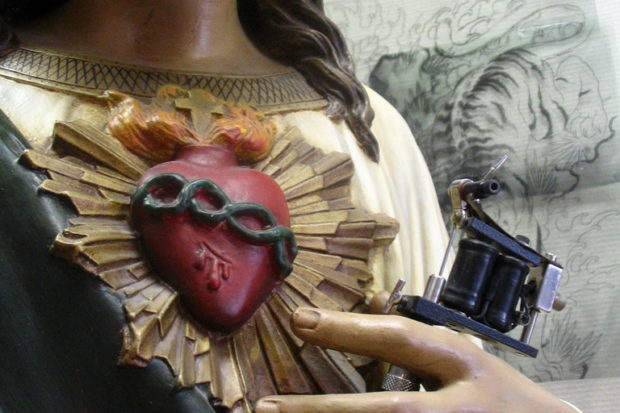

Progressive Religion is not an Oxymoron
Many social progressives have long been put off by the vast number of Christians who turn their back on those in society who have the greatest need and who trumpet, “Go to war, kill the evil ones!” This has led many progressives to respond by distancing themselves from Christianity, indeed, from religion in general.
And yet the core of Christianity is all about tending to those with the greatest needs-the poor, the oppressed, the sick, the marginalized-and is unqualifiedly nonviolent. It is as though another set of values has been superimposed on much of what is called Christianity in the United States.
The Gospel According to the Daily Show
In many church settings today, one can find extraordinary tension between the values inherent in the heart of Christianity and the values reflected in what actually is practiced in these churches.
This tension can give rise to outlandish outcomes that only can be called tragicomedy. Leave it to Jon Stewart’s Daily Show to illustrate this point: Recently, his show ran an “investigative” piece on two Christian churches whose clergy were using mixed martial arts and bodybuilding stunts to “win converts” to Christianity.
What a gift for Stewart and his crew! The unintentional parody was knee-slapping funny, better than anything that could have been scripted.
Smashed Mouths for Jesus?
With the mixed martial arts, getting your face smashed or smashing someone else’s face was a good thing because it could be instrumental in luring people to follow the Prince of Peace. Let’s bloody each other for Jesus, right?
In the second situation, the implication was that, somehow, Jesus was physically empowering these men: If you can invite Jesus into your heart, then this advocate for nonviolence would enable you to tear giant phone books in half or smash through big stacks of bricks by hand.
All of this might have had great appeal to me when I was the proverbial 98-pound weakling: You can be a physical stud and you can claim Jesus as well. A great bargain!
Alas, I am no longer the 98-pound weakling (at least the 98 pound part of it) nor am I in awe when I see steroid-styled men rip and smash things (though I wouldn’t want to get them angry with me).
Ecclesiastical Sideshows: No Biblical Basis
None of these sideshow acts has anything to do with the Jesus of the Christian New Testament. Neither do many of the other televangelists. These approaches cannot be biblically grounded. They exist only in someone’s imaginary bible.
In reality, there is nothing recorded in Jesus’ words in the New Testament that can be construed as advocating or supporting anything that resembles violence. At the same time (and in the same chapter of Matthew), there is no question about Jesus’ focus on the poor and those otherwise oppressed.
A Strong Biblical Basis for Nonviolence and for Helping the Poor
We have, instead, a number of other verses that point in the quite opposite direction, most particularly his comments about nonviolence:
- “Blessed are the peacemakers, for they will be called children of God.” (Matt. 5:9)
- “You have heard that it was said, ‘An eye for an eye and a tooth for a tooth.’ But I say to you, ‘Do not resist an evildoer. But if anyone strikes you on the right cheek, turn the other also.'” (Matt. 5:39)
- “You have heard that it was said, ‘You shall love your neighbor and hate your enemy.’ But I say to you, Love your enemies and pray for those who persecute you.'” (Matt 5:43-44)
Likewise, Jesus’ words on behalf of those with the greatest needs and the least power are expressed in the verses that have come to be called the Beatitudes (blessings) found just prior to the ones on nonviolence.
The Dark Side of Some Believers
The two clergy featured on the Daily Show were treated as buffoons-a treatment they had earned, I’m afraid. Others who wrap the cloak of Jesus around themselves, however, have a much darker agenda that aims at world domination by their version of the Christian faith.
Of course, to do this they need to rid the world of all evil, a goal that cannot be done by “friendly persuasion.” For example, I once saw the late Jerry Falwell in a video clip telling the audience that, as Christians, we should go and “kill the terrorists in the name of our Lord.”
Whoa, baby! Jesus wielding an automatic rifle. What an image: The militant Jesus! However, I have searched and searched, but I cannot find any trace of this Jesus in the Christian New Testament. The biblical Jesus, therefore, cannot be used a reason to smash faces, smash bricks, or smash bullets and bombs into people.
The Ethereal, Asexual Jesus
I also find another Jesus troubling, the purely good, ethereal, asexual wisp of a figure, someone not totally real, nearly a totally non-physical spirit. Informed by Plato’s philosophy, the idealized image is supposed to be more profound than anything actual; and inevitably the “real” essence is separated from the “base” physical body.
This second image is very much like the Jesus that I learned about when I was young. This view can do a great deal of damage as well, contributing to alienation from the body, sexuality in particular. It also can make Jesus and his teachings seem out of reach to mere human beings.
At least this second Jesus-the pure, unreal Jesus-does not open the door to physical violence on either a small or a large scale, unlike the militant Jesus certainly does. But, unfortunately, this second Jesus can be misused to reinforce a tendency in the already oppressed to be passive in response to their oppressors.
To Tell the Truth: Who Is the “Real” Jesus and Will He Please Stand Up?
So, who was the “real” Jesus and what was he like? Was he the warrior at heart, ready to lead the battle to slay the evildoers and definitely anti-socialist, challenging the poor to pick themselves up by their sandal straps? Or, was he the nearly non-material being whose purity could not get contaminated by mucking around in earthly form? Or, was he something else altogether?
Having to pick the correct one in a set of three takes me back to the old (ok, ancient) TV program called To Tell the Truth. The ever-shrinking handful among us who can remember watching small screen, black-and-white TVs also are likely to remember that old program.
On the show, there always would be three people claiming to be the same person. Two were fake and one was real. At the end, the host (Bud Collyer, Gary Moore or Joe Garagiola) would ask the real person to please stand up. There would be a variety of body feints (starting to stand, shifting in the chairs, eye and head movements), then the real person would finally rise from his or her seat.
What Was the “Real” Jesus Like, Anyway?
So, what would the real Jesus be like, the third man on the panel? This has been a much-discussed question since at least the late 19th century when Albert Schweitzer pursued the “quest for the historical Jesus.” Obviously, this is a difficult, if not impossible, question to answer for a time and place where little was written down until years and even decades later.
There are some lenses that have been developed through painstaking studies of history, language and culture, but any one or combination of these lenses has the potential to be subject to significant error.
Using the Sayings of Jesus to Better Understand This Particular Person
The words of Jesus do provide some basis for making judgments, yet even these have been subject to serious and prolonged scrutiny as to the extent of their validity as an actual saying of Jesus (e.g., the Jesus Seminar).
However, few Christians – scholars, clergy, and laity, from all faith perspectives – would argue with the primacy of Jesus’ words in the Beatitudes. These passages emphasize his deep concern to care for the poor and the otherwise marginalized, the ill, and so on. And, as pointed out above, Jesus’ words in the same chapter of Matthew make crystal clear his stance against violence and returning violence for violence.
This means that the “real” Jesus who finally stood up would be the one who held himself out as nonviolent with a strong socialist inclination.
Unfortunately, I don’t think the mainstream, Christian society of today would receive Jesus with any more enthusiasm than he was received by the dominant Roman and Jewish societies of 2,000 years ago. But, fellow progressives, you can rest assured that the Jesus of history, this third Jesus, would be in front of our vision, not standing in its way.
